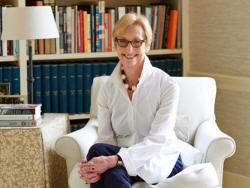|
Family plumbing supply
business evolved to high design
 Send a link to a friend
Send a link to a friend
 [November 11, 2016]
By Cheryl Lu-Lien Tan [November 11, 2016]
By Cheryl Lu-Lien Tan
NEW
YORK (Reuters) - What better business pursuit for the daughter of a
plumbing equipment supplier than bathroom design?
Since 1978, Barbara Sallick and her husband, Robert, have run the luxury
bath and kitchen design company Waterworks (www.waterworks.com/),
headquartered in Danbury, Connecticut. It was one of the first companies
to build showrooms for high-design fittings and fixtures for consumers,
rather than just plumbers, to browse.
Their son Peter is currently chief executive of the company, while
Barbara Sallick just published her third book, "The Perfect Bath." In
April, the company was acquired by Restoration Hardware for $117
million.
Sallick spoke with Reuters to share some of the guiding principles that
have steered her through the years.
Q: What early lesson about money has stuck with you?
A: My father started a plumbing supply business in 1925, and it was
still a fledgling when the Depression hit. Just as it was beginning to
flourish, we were engaged in World War II. He lived his life as if the
next disaster was around the corner. I was never sure where we stood
financially, because he was always saving for a rainy day. This is not
to say we were deprived in any way, but we were always encouraged to be
thoughtful about how we spent our money.

Q: What did launching your business teach you about finances?
A: Step one, it was clear that unless there was a solid strategic plan
in place, securing a bank loan would be impossible. The banks always
wanted to know that they would get paid back with interest, which in
1978 was a staggering 22 percent.
Q: What was your first job? How did it shape or change your work ethic?
A: As a 16-year-old, my very first summer job was in a local toy store
in Danbury, Connecticut. I had never worked before and it took me a
couple of weeks to figure out that the busier I was the faster the day
passed. So, without being asked, I started to straighten shelves, make
sure all of the games were adjacent to one another and neatly stacked,
soft toys were in baskets and the place was dust free. The owner noticed
and I quickly got a 25-cent per hour raise. Recognition drives job
satisfaction. I have carried this early lesson with me throughout my
life and use this story as I mentor young employees.
[to top of second column] |

Barbara Sallick in an undated photo. REUTERS/Courtesy Waterworks

Q: Do you work with a financial adviser?
A: For many years we worked with an investment counselor. The results
were mixed. Only recently, we engaged a financial adviser who is
strategically planning for our future. This includes investigating
insurance policies, stock portfolios, our collection of decorative arts,
our will, our real estate and my husband’s well-being including diet and
exercise.
While we are very late in finding the right person to be our adviser, I
would suggest outside and objective guidance as soon you understand the
trajectory of your career. The discipline she or he can bring to your
finances will be invaluable over the years.
Q: How do you decide where to allocate your charitable money?
A: I have been a stalwart contributor to my alma mater, Wheelock College
in Boston. Its very clear mission of “improving the lives of children
and families” resonates with me. I admire anyone who is interested in a
teaching career knowing that the likelihood of becoming wealthy is
non-existent.
I also have been on the board of and a contributor to the Institute of
Classical Architecture and Art. On a smaller scale, I donate to women’s
organizations locally.
Q: What money lessons did you pass down to your family?
A: I am afraid we were not the best role models for fiscal
responsibility. Our business, our house, our commercial building, school
tuition and even the next great piece of furniture took precedence over
savings and investment. We have been playing catch-up for a while.
Our son was able to observe our shortcomings as financial planners. I
see a healthy future for the next generation.
(Editing by Beth Pinsker and Phil Berlowitz)
[© 2016 Thomson Reuters. All rights
reserved.] Copyright 2016 Reuters. All rights reserved. This material may not be published,
broadcast, rewritten or redistributed.
 |